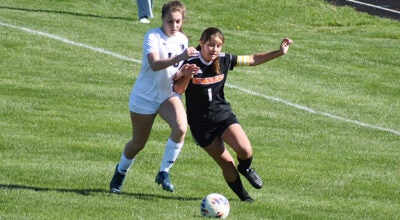Michigan International backdrop to new book
Published 8:44 am Thursday, March 18, 2010
BROOKLYN – For one, there’s a memorable scene in which the author spends a sleepless night in a snoring fan’s bus in the infield at Michigan International Speedway.
For another, MIS track president Roger Curtis participates in several scenes of late-night high jinks with fans.
Instead of using historic races or champion drivers, NASCAR insider Andrew Giangola explains the history and popularity of NASCAR through the eyes – and the converted school buses – of the fans. Giangola scoured the NASCAR Sprint Cup Series circuit, finding fan stories that are hilarious and heart breaking.
It’s no surprise Michigan International Speedway, which has hosted NASCAR Sprint Cup Series Races since 1969 and boasts some of the most devoted campers in NASCAR, is the setting for several of the book’s most memorable tales of over-the-top fandom.
One fan known to thousands at MIS is Kevin Kent, proprietor of “Bob’s Party Bus,” an amusement park-worthy attraction thousands of race-goers experience each summer. The bus is covered inside and out with a psychedelic paint scheme in drips and streaks and splatters of florescent paint, colorful gobs slung on the walls and seats and floors.
As Giangola writes, “When darkness falls over the race track, fans wait their turn to climb aboard the psychedelic bus, putting on 3-D glasses to view a twisting, oozing menagerie of electric blues, hot pinks, ruby reds, canary yellows and lime greens, a demented mix of color in a shifting landscape that throws anyone walking through the bus into a trippy, 60’s frame of mind.”
Kent, who was a binge-drinker for many years then surrendered his life to Christ after seeing a Christian band play at the race track, is a fixture by the back emergency exit, wearing a coat and hat speckled in neon paint, and handing out Bibles and church service DVDs.
“Before I was saved, this bus was the scene for one non-stop, hard-core party,” he said. “I used to put pasties on girls coming through. Now I give them my testimony. You could say we went from The Pasties Bus to God’s Bus.”
Giangola was introduced to Kent by Craig and Jackie Reda, whose converted 1983 yellow school bus is a stone’s throw from Bob’s Party Bus in the MIS infield. Jackie, a beautician, and Craig, a carpenter, are featured in the chapter “Hearts Big and Brave.”
The couple from Frankenmuth, Mich., collects signatures of NASCAR drivers, crew members and race and track officials. More than a hundred cover the cream domed ceiling of their yellow school bus.
“It is a roster of marvelous signatures forming a tapestry of lives intersecting at the race track, some scribbled with the fine-art intricacy of Arabic, some in chunky bold caps, could be a back-of-the-pack, over-the-wall jack man not getting much attention but now the recipient of a special moment immortalized on the sloped roof of the 1972 Ford bus, courtesy of two down-home NASCAR fans,” Giangola writes.
Jackie and Craig are also good friends with Curtis, first meeting in 2006 when security stopped their bus entering the track gates. Craig wondered which rule he’d broken. He pushed open the tall double-door like a driver picking up a kid on the way to school, and the new track president bound up the stairs, introduced himself, and thanked them for coming to the race.
“Right there, we knew Roger was a different breed,” Jackie said.
At the June 2009 Sprint Cup race, Curtis rolled up to the Reda’s campsite in his Chevy Tahoe and motioned for the couple to jump in. They got a big surprise when Curtis pointed the vehicle onto the track and floored it.
“He was laughing the whole time, saying, ‘Oh boy, we’re gonna get in trouble for this!'” Jackie said.
Track security came blasting onto the scene as the president and his fan friends barreled around the oval. The men in badges started to reprimand Curtis, then realized it was the boss man wheeling this late-night hot lap.
Curtis once came by the camp site for one of Jackie’s steaks. He asked Craig to name the one thing that would markedly improve his fan experience. This was a no-brainer. “A Big Screen TV right over there,” Craig said, pointing to the outside wall in the middle of the 2,200-foot backstretch and referring to one of the track’s nine Sprint Vision jumbo screens.
The next race, pulling the bus into his spot, Craig Reda looked up and there it was: a giant screen right where he suggested.
“Roger sees his job as ‘How do I make you happy? What can I do for you today?'” Craig Reda said.
For his part, Curtis says he’s simply a fan at heart who has never let a pursuit of “market share” cloud a much more important goal: making every single ticket holder’s experience memorable. And while he can’t always make everything a fan wants happen instantly, most of the changes at MIS over the past four years are a direct result of fan input.
From his office in the administrative building, Curtis can see the seats he had as a fan for many years near the start-finish line. He remembers what it’s like to buy a ticket simply to have a blast at the track – and now he’s doing his best to personally make that happen.
The full story of Kevin Kent’s marvelous bus and Craig and Jackie Reda’s adventures with Roger Curtis can be found in “The Weekend Starts on Wednesday: True Stories of Remarkable NASCAR Fans”(Motorbooks, 304 pages with 99 color photos).
The book is available on amazon.com, the NASCAR.COM SuperStore and wherever fine books are sold.





